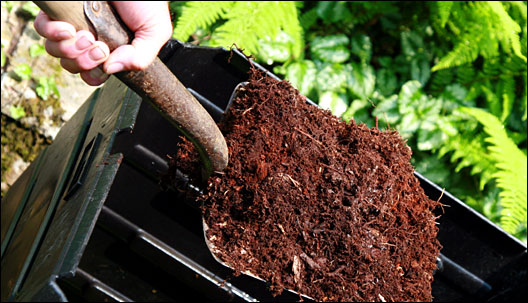 Do you know what’s in your compost?The growing number of municipal and commercial composting operations has been one of the few bright spots in the environmental landscape, from San Francisco’s curbside composting service to this industrial-scale composting facility in Delaware. But Josh Harkinson in Mother Jones has harshed our green-tinged buzz.
Do you know what’s in your compost?The growing number of municipal and commercial composting operations has been one of the few bright spots in the environmental landscape, from San Francisco’s curbside composting service to this industrial-scale composting facility in Delaware. But Josh Harkinson in Mother Jones has harshed our green-tinged buzz.
Thanks to fractured or lax regulations as well as the ubiquitous contamination of our environment by industrial chemicals (particularly heavy metals and pesticides), there’s a distressingly real risk of toxic chemicals making it into commercial and municipal compost. And it’s a particular problem for organic growers:
Pesticide-laced compost has presented a quandary for the USDA’s National Organic Program ever since California regulators traced residues of dichlorophenyl-dichloroethylene, a breakdown product of DDT, and bifenthrin, an ant killer, to compost in pots of organic wheatgrass in Northern California grocery stores (the levels were not high enough to make anyone sick). DDT was banned for most uses in the early ’70s and bifenthrin is classified as a possible human carcinogen and is highly toxic to fish. The NOP initially proposed setting a strict upper limit for bifenthrin levels in compost but abandoned the idea when wider tests revealed that many brands of commercial compost wouldn’t pass. Regulators ultimately decided to allow any level of contamination in compost so long as “residual pesticide levels do not contribute to the contamination of crops, soil, or water.”
Complicating matters, there is no actual organic standard for compost. In other words, despite claims on packages, there is no such thing as “USDA Organic Compost.” As Harkinson observes, some states like California test for contaminants while others (I’m looking at you, Texas) don’t.
And then there are pesticide makers who typically have refused to disclose whether their pesticides break down well or at all in compost, as occurred recently with DuPont and its weed killer Imprelis.
Harkinson encourages consumers to know their composter, ideally by noting where the compost is produced (not always easy to determine) and understanding the different toxics that may be present. Once again, the consumer is wandering in the dark because our state and federal government won’t provide proper oversight.
But even with the risks, commercial compost is a far better and safer soil amendment than another municipal product that companies and (to a surprising extent) the EPA are pushing on consumers: sewage sludge, aka biosolids. See Grist’s series on the history of industry and government efforts to get sewage sludge onto American gardens. The range of toxins in sewage sludge is terrifying — basically anything that gets washed down the drain or ends up in rivers, including not just heavy metals and pesticides, but pharmaceuticals (lots of Prozac, antibiotics, and birth-control-pill hormones), flame retardants, and even dioxin. The real caveat emptor should go to people who buy garden products made of sewage sludge, an ingredient which very often is not noted on the package label.
Harkinson neglects to mention the easiest way to control the content of your compost — grow your own! You don’t need much space, and if you buy organic then your fruit and vegetable scraps, i.e. your raw materials, will be virtually free from chemical contamination and will produce “clean” compost. As with many aspects of the food system these days, with compost it may be best to take matters into your own hands.



